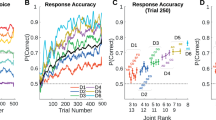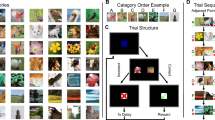Abstract
Understanding how organisms make transitive inferences is critical to understanding their general ability to learn serial relationships. In this context, transitive inference (TI) can be understood as a specific heuristic that applies broadly to many different serial learning tasks, which have been the focus of hundreds of studies involving dozens of species. In the present study, monkeys learned the order of 7-item lists of photographic stimuli by trial and error, and were then tested on “derived” lists. These derived test lists combined stimuli from multiple training lists in ambiguous ways, sometimes changing their order relative to training. We found that subjects displayed strong preferences when presented with novel test pairs, even when those pairs were drawn from different training lists. These preferences were helpful when test pairs had an ordering congruent with their ranks during training, but yielded consistently below-chance performance when pairs had an incongruent order relative to training. This behavior can be explained by the joint contributions of transitive inference and another heuristic that we refer to as “positional inference.” Positional inferences play a complementary role to transitive inferences in facilitating choices between novel pairs of stimuli. The theoretical framework that best explains both transitive and positional inferences is a spatial model that represents both the position of each stimulus and its uncertainty. A computational implementation of this framework yields accurate predictions about both correct responses and errors on derived lists.











Similar content being viewed by others
References
Alvarado MC, Bachevalier J (2005) Comparison of the effects of damage to the perirhinal and parahippocampal cortex on transverse patterning and location memory in rhesus macaques. J Neurosci 25:1599–1609
Bond AB, Wei CA, Kamil AC (2010) Cognitive representation in transitive inference: a comparison of four corvid species. Behav Proc 85:283–295
Carpenter B, Gelman A, Hoffman M, Lee D, Goodrich B, Betancourt M, Brubaker MA, Guo J, Li P, Riddell A (2017) Stan: a probabilistic programming language. J Stat Softw 76:1–32
Chen S, Swartz KB, Terrace HS (1997) Knowledge of the ordinal position of list items in rhesus monkeys. Psychol Sci 8:80–86
Couvillon PA, Bitterman ME (1996) Transverse patterning in pigeons. Anim Learn Behav 24:410–422
D’Amato MR, Colombo M (1990) The symbolic distance effect in monkeys (Cebus apella). Anim Learn Behav 18:133–140
Daniels CW, Laude JR, Zentall TR (2014) Transitive inference by pigeons: does the geometric presentation of the stimuli make a difference? Anim Cogn 17:973–981
Ebbinghaus H (1885|1913) Memory: a contribution to experimental psychology. HA Ruger (Trans). Teachers College, Columbia University, Bureau of Publications
Ebitz RB, Sleezer BJ, Jedema HP, Bradberry CW, Hayden BJ (2019) Tonic exploration governs both flexibility and lapses. PLOS Comput Biol 15:e1007475
Gazes RP, Chee NW, Hampton RR (2012) Cognitive mechanisms for transitive inference performance in rhesus monkeys: measuring the influence of associative strength and inferred order. J Exp Psychol Anim Behav Process 38:331–345
Gazes RP, Lazareva OF, Bergene CN, Hampton RR (2014) Effects of spatial training on transitive inference performance in humans and rhesus monkeys. J Exp Psychol Anim Learn Cognit 40:477–489
Gelman A, Carlin JB, Stern HS, Dunson DB, Vehtari A, Rubin DB (2014) Bayesian data analysis, 3rd edn. CRC Press
Gross WL, Greene AJ (2007) Analogical inference: the role of awareness in abstract learning. Memory 15:838–844
Heino MTJ, Vuorre M, Hankonen N (2018) Bayesian evaluation of behavioral change interventions: a brief introduction and a practical example. Health Psychol Behav Med 6:49–78
Hintze JL, Nelson RD (1998) Violin plots: a box plot-density trace synergism. Am Stat 52:181–184
Hotta T, Ueno K, Hataji Y, Kuroshima H, Fujita K, Kohda M (2020) Transitive inference in cleaner wrasses (Labroides dimidiatus). PLoS ONE 15:e0237817
Jacobs LF (2006) From movement to transitivity: the role of hippocampal parallel maps in configural learning. Rev Neurosci 17:99–109
Jaro MA (1989) Advances in record linkage methodology as applied to the 1985 census of Tampa Florida. J Am Stat Assoc 84:414–420
Jensen G (2017) Serial learning. In: Call J, Burghardt GM, Pepperberg IM, Snowdon CT, Zentall T (eds) APA handbook of comparative psychology: vol. 2, perception, learning, and cognition. American Psychological Association, pp 385–409
Jensen G, Altschul D, Danly E, Terrace HS (2013) Transfer of a serial representation between two distinct tasks by rhesus macaques. PLoS ONE 8:e70285
Jensen G, Muñoz F, Alkan Y, Ferrera VP, Terrace HS (2015) Implicit value updating explains transitive inference performance: the betasort model. PLOS Comput Biol 11:e1004523
Jensen G, Alkan Y, Muñoz F, Ferrera VP, Terrace HS (2017) Transitive inference in humans (Homo sapiens) and rhesus macaques (Macaca mulatta) after massed training of the last two list items. J Comp Psychol 131:231–245
Jensen G, Alkan Y, Ferrera VP, Terrace HS (2019) Reward associations do not explain transitive inference performance in monkeys. Sci Adv 5:eaaw2089
Kao T, Jensen G, Michaelcheck C, Ferrera VP, Terrace HS (2020) Absolute and relative knowledge of ordinal position. J Exp Psychol Learn Mem Cognit 46:2227–2245
Lashley KS (1951) The problem of serial order in behavior. In: Jeffress LA (ed) Cerebral mechanisms in behavior. Wiley, New York, pp 112–131
Lazareva OF (2012) Transitive inference in nonhuman animals. In: Zentall TR, Wasserman EA (eds) Oxford handbook of comparative cognition. Oxford University Press, Oxford, pp 718–735
Lazareva OF, Wasserman EA (2006) Effect of stimulus orderability and reinforcement history on transitive responding in pigeons. Behav Proc 72:161–172
Lazareva OF, Wasserman EA (2012) Transitive inference in pigeons: measuring the associative value of stimuli B and D. Behav Proc 89:244–255
Lazareva OF, Gazes RP, Elkins Z, Hampton R (2020) Associative models fail to characterize transitive inference performance in rhesus monkeys (Macaca mulatta). Learn Behav 48:135–148
McElreath R (2020) Statistical rethinking: a Bayesian course with examples in R and Stan, 2nd edn. CRC Press, Boca Raton
McGonigle BO, Chalmers M (1977) Are monkeys logical? Nature 267:694–696
Merritt DJ, Terrace HS (2011) Mechanisms of inferential order judgments in humans (Homo sapiens) and rhesus monkeys (Macaca mulatta). J Comp Psychol 125:227–238
Reid AK (2009) Resistance to change within heterogeneous response sequences. J Exp Psychol Anim Behav Process 35:293–311
Roberts WA, Phelps MT (1994) Transitive inference in rats: a test of the spatial coding hypothesis. Psychol Sci 5:368–374
Tanner N, Jensen G, Ferrera VP, Terrace HS (2017) Inferential learning of serial order of perceptual categories by rhesus monkeys (Macaca mulatta). J Neurosci 37:6268–6276
Templer VL, Gazes RP, Hampton RR (2019) Co-operation of long-term and working memory representations in simultaneous chaining by rhesus monkeys (Macaca mulatta). Q J Exp Psychol 72:2208–2224
Terrace HS (1986) A nonverbal organism’s knowledge of ordinal position in a serial learning task. J Exp Psychol Anim Behav Process 12:203–214
Terrace HS (2005) The simultaneous chain: a new approach to serial learning. Trends Cognit Sci 9:202–210
Terrace HS (2010) The comparative psychology of serially organized behavior. Comp Cognit Behav Rev 4:39–73
Terrace HS (2012) The comparative psychology of ordinal behavior. In: Zentall TR, Wasserman EA (eds) Oxford handbook of comparative cognition. Oxford University Press, pp 615–651
Thomas L, Juanes F (1996) The importance of statistical power analysis: an example from animal behaviour. Anim Behav 52:856–859
Tibbetts EA, Agudelo J, Pandit S, Riojas J (2019) Transitive inference in Polistes paper wasps. Biol Lett 15:20190015
Treichler FR (2012) Serial list retention by non-human primates: complexity and cognitive continuity. In: McFarland D, Stenning K, Mcgonigle-Chalmers M (eds) The complex mind: an interdisciplinary approach. Palgrave Macmillan, pp 25–37
Treichler FR, Raghanti MA (2010) Serial list combination by monkeys (Macaca mulatta): test cues and linking. Anim Cognit 13:121–131
Treichler FR, Van Tilburg D (1996) Concurrent conditional discrimination tests for transitive inference by macaque monkeys: list linking. J Exp Psychol Anim Behav Process 22:105–117
Treichler FR, Raghanti MA, Van Tilburg D (2003) Linking of serially ordered lists by macaque monkeys (Macaca mulatta): list position influences. J Exp Psychol Anim Behav Process 29:211–221
Treichler FR, Raghanti MA, Van Tilburg D (2007) Serial list combination by macaque monkeys (Macaca mulatta): list property limitations. J Comp Psychol 121:250–259
Vasconcelos M (2008) Transitive inference in non-human animals: an empirical and theoretical analysis. Behav Proc 78:313–334
von Fersen L, Wynne CDL, Delius JD, Staddon JER (1991) Transitive inference formation in pigeons. J Exp Psychol Anim Behav Process 17:334–341
Weaver J, Steirn JN, Zentall TR (1997) Transitive inference in pigeons: control for differential value transfer. Psychon Bull Rev 4:113–117
Wei CA, Kamil AC, Bond AB (2014) Direct and relational representation during transitive list linking in pinyon jays (Gymnorhinus cyanocephalus). J Comp Psychol 121:250–259
Wynne CDL (1995) Reinforcement accounts for transitive inference performance. Anim Learn Behav 23:207–217
Wynne CDL (1997) Pigeon transitive inference: tests of simple accounts of a complex performance. Behav Proc 39:95–112
Zentall TR, Clement TS (2001) Simultaneous discriminative learning: stimulus interactions. Anim Learn Behav 29:311–325
Acknowledgements
We thank Yelda Alkan, David Freshwater, Aliza Gross, Katherine Liu, and Grant Spencer for assistance with data collection.
Funding
This work was supported by US National Institute of Mental Health, Grant numbers NIH-MH081153 and NIH-MH111703 awarded to Vincent Ferrera and Herbert Terrace.
Author information
Authors and Affiliations
Corresponding author
Additional information
Publisher's Note
Springer Nature remains neutral with regard to jurisdictional claims in published maps and institutional affiliations.
Supplementary Information
Below is the link to the electronic supplementary material.
Rights and permissions
About this article
Cite this article
Jensen, G., Ferrera, V.P. & Terrace, H.S. Positional inference in rhesus macaques. Anim Cogn 25, 73–93 (2022). https://doi.org/10.1007/s10071-021-01536-x
Received:
Revised:
Accepted:
Published:
Issue Date:
DOI: https://doi.org/10.1007/s10071-021-01536-x




